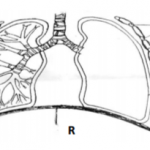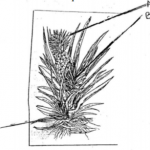KNEC KCSE Biology Paper 2 – 2014 Cross Country Mock
2014 Cross Country Mock
Biology Paper 2
SECTION A (40 Marks)
Answer all questions in this section.
1. a) What is immunity to a disease (1mk)
……………………………………………………………………………………………….. ………………………………………………………………………………………………..
b) Distinguish between the following types of immunity
(i) Natural immunity (1mk)
……………………………………………………………………………………………….. ………………………………………………………………………………………………..
(ii) Artificial immunity (1mk)
……………………………………………………………………………………………….. ………………………………………………………………………………………………..
3 marks
The figure below represents a transverse section of a root
i) Name the parts labeled A, B and D (3mks)
……………………………………………………………………………………………….. ……………………………………………………………………………………………….. ……………………………………………………………………………………………….. ………………………………………………………………………………………………..
ii) State the role of the part labeled C (1mk)
……………………………………………………………………………………………….. ………………………………………………………………………………………………..
4 marks
a) Define the term balanced diet (2mks)
……………………………………………………………………………………………….. ………………………………………………………………………………………………..
b) Explain the importance of each of the following during digestion in human beings
(i) Teeth (1mk)
……………………………………………………………………………………………….. ………………………………………………………………………………………………..
ii) Saliva (2mks)
……………………………………………………………………………………………….. ………………………………………………………………………………………………..
c) State the role of each of the following in photosynthesis (3mks)
(i) Light
……………………………………………………………………………………………….. ………………………………………………………………………………………………..
ii) Chlorophyll
……………………………………………………………………………………………….. ………………………………………………………………………………………………..
iii) Carbon (IV) oxide ………………………………………………………………………………………………..
9 marks
Study the diagram below and answer the questions that follow.
a) Name the principle labeled X (1mk) ………………………………………………………………………………………………..
b) If the above diagram represented blood sugar regulation
(i) State the corrective mechanisms carried out at A (2mks) ……………………………………………………………………………………………….. ……………………………………………………………………………………………….. ………………………………………………………………………………………………..
ii) The condition that may result from the further excess (1mk) ……………………………………………………………………………………………….. ………………………………………………………………………………………………..
iii) the hormone that would be responsible for correcting the deficiency (1mk) ……………………………………………………………………………………………….. ………………………………………………………………………………………………..
c) Give the reasons as to why plants have less elaborate excretory systems as compared to
animals (3mks)
……………………………………………………………………………………………….. ……………………………………………………………………………………………….. ……………………………………………………………………………………………….. ……………………………………………………………………………………………….. ……………………………………………………………………………………………….. ………………………………………………………………………………………………..
10 marks
a) State two effects of air pollution to plants (2mks) …………………………………………………………………………………………………
…………………………………………………………………………………………………
…………………………………………………………………………………………………
…………………………………………………………………………………………………
…………………………………………………………………………………………………
b) Name two human activities that cause soil pollution (2mks) …………………………………………………………………………………………………
…………………………………………………………………………………………………
c) How is plasmodium adapted to cause malaria (2mks) …………………………………………………………………………………………………
…………………………………………………………………………………………………
…………………………………………………………………………………………………
…………………………………………………………………………………………………
d) State two ways of controlling the transmission of typhoid (2mks) …………………………………………………………………………………………………
…………………………………………………………………………………………………
…………………………………………………………………………………………………
…………………………………………………………………………………………………
8 marks
SECTION B (40 Marks)
Answer question 6 (compulsory) and any other one question in the spaces provided after question 8.
The data below shows results obtained from a plant species which was planted around a
homestead to serve as a hedge. The hedge was divided into part I, II and III. The three parts
were treated as indicated in the table and the results collected after 3 years.
| Part | Treatment | Percentage cover in the 1st 2 metres from the ground |
Average width in metres |
Average height in metres |
| I | Untrimmed throughout | 3% | 0.5 | 5.0 |
| II | Trimmed twice annually | 55% | 0.9 | 3.5 |
| III | Trimmed throughout | 85% | 1.5 | 2.5 |
a) Give three deductions one would draw from the above results (3mks) …………………………………………………………………………………………………
…………………………………………………………………………………………………
…………………………………………………………………………………………………
b) Explain the effects of the following on percentage cover; width of hedge and height of
plants
(i) Lack of hedge trimming (3mks)
…………………………………………………………………………………………………
…………………………………………………………………………………………………
…………………………………………………………………………………………………
…………………………………………………………………………………………………
(ii) Frequent hedge trimming (4mks) …………………………………………………………………………………………………
…………………………………………………………………………………………………
…………………………………………………………………………………………………
…………………………………………………………………………………………………
…………………………………………………………………………………………………
…………………………………………………………………………………………………
c) Using a germinating bean seedling with a 2cm long radical; describe how you would
investigate the region of growth on the radical (5mks) …………………………………………………………………………………………………
…………………………………………………………………………………………………
…………………………………………………………………………………………………
…………………………………………………………………………………………………
…………………………………………………………………………………………………
…………………………………………………………………………………………………
…………………………………………………………………………………………………
…………………………………………………………………………………………………
…………………………………………………………………………………………………
…………………………………………………………………………………………………
d) Name the kind of growth curve obtained
(i) for arthropods when changes in length of body plotted against time (1mk) …………………………………………………………………………………………………
…………………………………………………………………………………………………
ii) Give reason as to why this kind of curve is obtained for arthropods (2mks) …………………………………………………………………………………………………
…………………………………………………………………………………………………
iii) Name the hormone that inhibits metamorphosis in insects and where it is produced …………………………………………………………………………………………………
…………………………………………………………………………………………………
…………………………………………………………………………………………………
20 marks
a) Explain how the tracheal system in arthropods is adapted for gaseous exchange
(10mks) …………………………………………………………………………………………………
…………………………………………………………………………………………………
…………………………………………………………………………………………………
…………………………………………………………………………………………………
…………………………………………………………………………………………………
…………………………………………………………………………………………………
…………………………………………………………………………………………………
…………………………………………………………………………………………………
…………………………………………………………………………………………………
…………………………………………………………………………………………………
…………………………………………………………………………………………………
…………………………………………………………………………………………………
…………………………………………………………………………………………………
…………………………………………………………………………………………………
…………………………………………………………………………………………………
b) Explain the mechanism of opening and closing of the stomata using photosynthetic theory …………………………………………………………………………………………………
…………………………………………………………………………………………………
…………………………………………………………………………………………………
…………………………………………………………………………………………………
…………………………………………………………………………………………………
…………………………………………………………………………………………………
…………………………………………………………………………………………………
…………………………………………………………………………………………………
…………………………………………………………………………………………………
…………………………………………………………………………………………………
…………………………………………………………………………………………………
…………………………………………………………………………………………………
…………………………………………………………………………………………………
…………………………………………………………………………………………………
20 marks







